After covering the basics of the Primal Pattern Movements I now want to go into greater depth on each one so that you are able to better implement them into your own training programs. These can all be put into both work outs and work-ins depending on the intensity you use and breathing patterns. I want to state that these next few weeks will not substitute for learning proper program design, which is very in depth if done correctly, but to give you some ideas about how and where to put specific movements in your regular routine. Please refer back to my previous post on proper squat form. This is now what to use squat movement patterns for and to give you some variety!
Bodyweight Squat
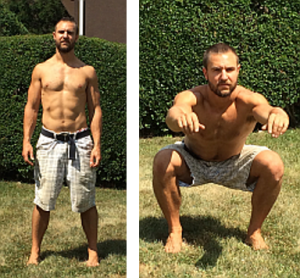 This is the gold standard to which all squats are compared. You must get this one right before you move on to the others because you must achieve proper form here first before adding weight.
This is the gold standard to which all squats are compared. You must get this one right before you move on to the others because you must achieve proper form here first before adding weight.
Swiss Ball Wall Squat
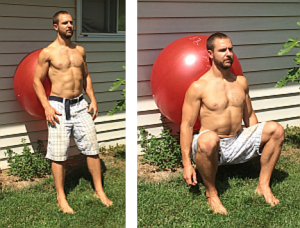 I’ve said it before and I’ll say it again here. The Swiss Ball is an excellent piece of exercise equipment. When put behind the back up against the wall it can make the basic bodyweight squat a little simpler for those who are still struggling with it.
I’ve said it before and I’ll say it again here. The Swiss Ball is an excellent piece of exercise equipment. When put behind the back up against the wall it can make the basic bodyweight squat a little simpler for those who are still struggling with it.
Box Squat/Sits to Stands
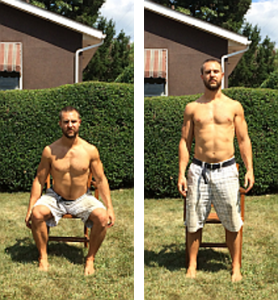 Using a box to squat down is something that has been used in the power-lifting world for years and can be a great benefit for those first learning to put the bar on their back. It can be used to teach depth, how to sit into a squat, work on explosion out of the bottom and even decrease give a high load training effect without as much muscular and central nervous system fatigue. Compare this to a sit to stand just using a simple chair is also a great option for those just making sure they can get up and out of a chair or off the toilet without assistance.
Using a box to squat down is something that has been used in the power-lifting world for years and can be a great benefit for those first learning to put the bar on their back. It can be used to teach depth, how to sit into a squat, work on explosion out of the bottom and even decrease give a high load training effect without as much muscular and central nervous system fatigue. Compare this to a sit to stand just using a simple chair is also a great option for those just making sure they can get up and out of a chair or off the toilet without assistance.
Back Squat
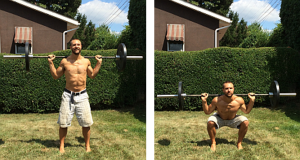 Now time for the “king of all exercises.” Put a bar on your back, go down and come back up. I have found these to be great for building strength when getting into the 3-5 rep range, but for a real treat I like cranking them up to 20-30 reps. For some insight on this I encourage you to read the book Super Squats by Randall J. Strossen. He shows you how to put on some serious muscle with a program doing heavy weight squats for high reps. I have done this before and seen amazing results. These are not for the faint of heart and you must make sure that your recovery is spot on because when it is these can send your testosterone and growth hormone through the roof. Sleep, working in and eating right will be critically important.
Now time for the “king of all exercises.” Put a bar on your back, go down and come back up. I have found these to be great for building strength when getting into the 3-5 rep range, but for a real treat I like cranking them up to 20-30 reps. For some insight on this I encourage you to read the book Super Squats by Randall J. Strossen. He shows you how to put on some serious muscle with a program doing heavy weight squats for high reps. I have done this before and seen amazing results. These are not for the faint of heart and you must make sure that your recovery is spot on because when it is these can send your testosterone and growth hormone through the roof. Sleep, working in and eating right will be critically important.
Front Squat
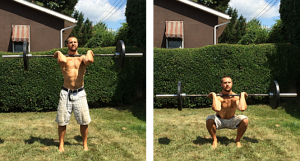 The front squat is an amazing exercise that does much more than meets the eye. Here we come across an exercise that has great benefits of the squat, but also is tremendous at strengthening the upper back as well. This is so important for many of us with in increased thoracic kyphosis or rounded upper back from sitting all day and staring at computer screens.
The front squat is an amazing exercise that does much more than meets the eye. Here we come across an exercise that has great benefits of the squat, but also is tremendous at strengthening the upper back as well. This is so important for many of us with in increased thoracic kyphosis or rounded upper back from sitting all day and staring at computer screens.
Goblet Squat
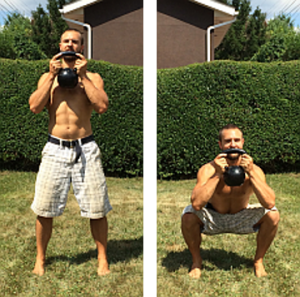 This is a front squat with a dumbbell or kettlebell and can be a great way to transition into the front squat as not as much thoracic, shoulder and wrist range of motion is required.
This is a front squat with a dumbbell or kettlebell and can be a great way to transition into the front squat as not as much thoracic, shoulder and wrist range of motion is required.
Overhead Squat
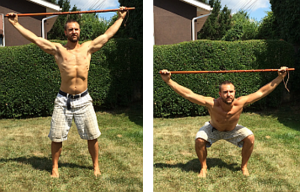 This is how to test if somebody has true range of motion in every joint in the body. That’s right- head up, full shoulder and thoracic range of motion, a stable lumbar spine, great hip mobility as well as getting the motion from the ankles.
This is how to test if somebody has true range of motion in every joint in the body. That’s right- head up, full shoulder and thoracic range of motion, a stable lumbar spine, great hip mobility as well as getting the motion from the ankles.
Zercher Squat
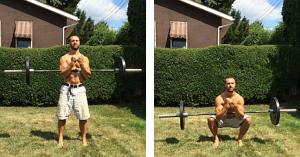 Another slick alternative to change up the loading on the squat is the Zercher squat where one holds the bar in the crux of their elbows. It can be used for those with a wrist/hand injury or even a shoulder injury when you are unable to get your hands back on the bar.
Another slick alternative to change up the loading on the squat is the Zercher squat where one holds the bar in the crux of their elbows. It can be used for those with a wrist/hand injury or even a shoulder injury when you are unable to get your hands back on the bar.
Sumo Squat
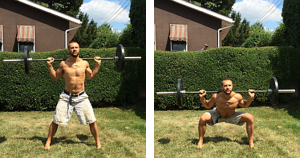 Here is another variation that is great for strengthening the hip adductors or inside of the leg and can be used with any of the above variations. I am a big fan of using this for those with an unstable low back and sacrum because it allows for force closure of the hip bones on the sacrum. This stability is critical for those that have a lot of low back pain. It is also nice to add a different stimulus to the body and is also used in many power-lifting circles.
Here is another variation that is great for strengthening the hip adductors or inside of the leg and can be used with any of the above variations. I am a big fan of using this for those with an unstable low back and sacrum because it allows for force closure of the hip bones on the sacrum. This stability is critical for those that have a lot of low back pain. It is also nice to add a different stimulus to the body and is also used in many power-lifting circles.
Squatting Depth
In a lot of lifting competitions full squat depth is considered when the hip crease is below the top of the knee or the femur is parallel to the ground. When it comes to the individual it depends on one’s goals. If you are lifting then this is where you need to hit. If you are trying to just get by you need to be able to get down to an average height toilet seat which is 16 inches and the same goes for the average chair. I feel that everybody should be able to hit a rock bottom or “ass to the grass squat.” This would be full expression of human movement and is how our ancestors and many people in the so called third world sit. It is something that I still am working on from so many years of sitting and I encourage you to do the same. This is by no means a complete list, but just something to get you started with a little bit of variety. It is still imperative that you master the basics before jumping into a sumo front squat on a low box with chains. Remember not to always chase the new and shiny object as it does not always fit in with what you need.
Have a Great Day!
Nick Horowski
Follow me on Facebook and Twitter. Subscribe to my Newsletter to receive email updates. Thank you for your support!
Before you go: I would love to hear about your goals and aspirations. Please share with a comment ![]()
